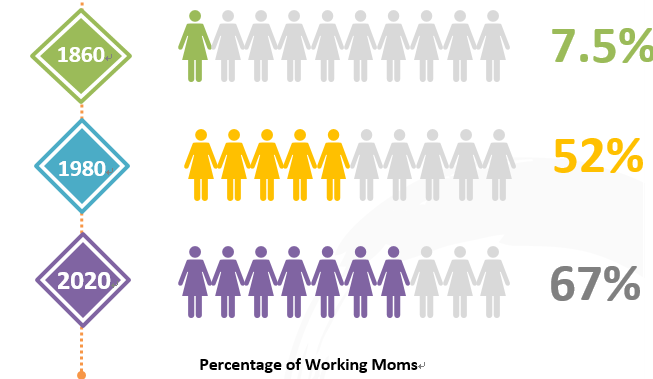History of the Term "Working-Mothers"
Erica hit the snooze button. She tossed in bed and shut her eyes, trying to get extra five-minute sleep. As she was about to fall asleep, the alarm went off again. "Time flies," her voice sarcastically echoed in her head. It is time to get out of bed. After stretching her arms a couple of times, she jumped out of bed. It was still 7-am, yet she was exhausted.
Last night was very tiring. She came home late at night after a hectic day at work. Then she had to prepare lunch, followed by helping her 4th grader study for her test.
The day does not end there. She had to work on a costume for her seven-year-old school party, only to go to bed around 2-am. Although today is a new day, she still needed to recover from yesterday's running around. Was it only yesterday's running around? Looking back, it is the story of everyday life.
Moreover, it is not only Erica's story; it is the story of all working mothers. Mothers who need to run from work to home. Once they are home, a whole new job starts. If it is hard enough to juggle two jobs at a time, then juggling work and being a mother takes a whole new dimension.
It is not only about a bunch of a whole new lot of tasks, but it is also about handling a whole load of emotions. It is your full responsibility to take care of other human beings who are your sole responsibility.
When did the Term Working-Mothers Starts?
On National Business Women’s Day, let us explore together the answer to that question.
It wasn't simply the women's liberation movement that encouraged mothers to work. The pattern dates back to Abraham Lincoln's presidency when 7.5 percent of moms worked. According to Ancestry.com, which analyzed 150 years of census records to identify the patterns of working mothers, 67 percent of mothers with children at home, work today. But it was not always a smooth ascent. This number has decreased in recent years.
It jumped in others, such as during combat. The most significant increase occurred in 1980 when working mothers passed the halfway point (52 percent) and grew by 12.6 percent over the previous year1.

1Amy Joyce, Washington Post 2014, The History of Mothers and Working, Accessed 9 August 2021, https://www.washingtonpost.com/news/parenting/wp/2014/05/08/the-history-of-mothers-and-working/
For more about this topic, download our latest book "One Woman Two Jobs" for FREE:
